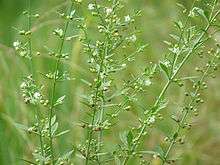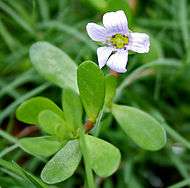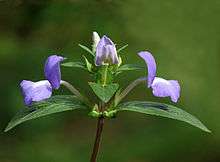Plantaginaceae
Plantaginaceae, the plantain family, is a family of flowering plants in the order Lamiales. In older classifications it used to be the only family of the order Plantaginales, but numerous phylogenetic studies, summarized by the Angiosperm Phylogeny Group, have demonstrated that this taxon should be included within Lamiales.
| Plantaginaceae | |
|---|---|
 | |
| Scoparia dulcis | |
| Scientific classification | |
| Kingdom: | Plantae |
| Clade: | Tracheophytes |
| Clade: | Angiosperms |
| Clade: | Eudicots |
| Clade: | Asterids |
| Order: | Lamiales |
| Family: | Plantaginaceae Juss.[1] |
| Type genus | |
| Plantago | |
| Tribes | |
| |
| Synonyms[2] | |
| |
Overview
The plantain family as traditionally circumscribed consisted of only three genera: Bougueria, Littorella, and Plantago. However phylogenetic research has indicated that Plantaginaceae sensu stricto (in the strict sense) were nested within Scrophulariaceae (but forming a group that did not include the type genus of that family, Scrophularia). Although Veronicaceae (1782) is the oldest family name for this group, Plantaginaceae (1789) is a conserved name under the International Code of Botanical Nomenclature (ICBN) and thus has priority over any earlier family name for a family including Plantago. Furthermore, the ICBN does not consider family names published before 1789 to be names eligible for conservation, thus ruling out Veronicaceae. The name Antirrhinaceae has been proposed for conservation over Plantaginaceae. In the meantime, the Angiosperm Phylogeny Group has accepted the name Plantaginaceae. However, Olmstead (2003)[3] chose to use the name Veronicaceae, a later synonym.
A group of genera including Lindernia has now been segregated [4][5] as the family Linderniaceae,[6] which is recognized by Haston et al. 2007 (also known as LAPG II) as "Post-APG II family".
Plantaginaceae sensu lato (in the broad sense) are a diverse, cosmopolitan family, occurring mostly in temperate zones. The group consists of herbs, shrubs and also a few aquatic plants with roots (such as the genus Callitriche). As the family is so diverse, its circumscription is difficult to establish.[4]
The leaves are spiral to opposite and simple to compound. Unusual in Lamiales is the absence of vertical partitions in the heads of the glandular hairs.
The structure and form of the flowers is variable. Some genera are 4-merous (i.e., with 4 sepals and 4 petals), such as Aragoa (but this one has 5 sepals); others are 5- to 8-merous, such as Sibthorpia. The flowers of most genera are polysymmetric. The corolla is often two-lipped. In some taxa, the androecium is formed before the corolla.
The fruit is a capsule that dehisces through the partitions between the cells.[7]
Genera


The enlarged Plantaginaceae consists of 94 genera and about 1,900 species.[8] The largest genus is Veronica, with about 450 species. Veronica also includes the genera Hebe, Parahebe and Synthyris, formerly often treated as distinct. All genera of Plantaginaceae were formerly included in Scrophulariaceae except where otherwise stated.
|
|
|
Although GRIN includes Lafuentea Lag. in the tribe Antirrhineae,[10] in the phylogenetic analysis of Fernández-Mazuecos et al. (2013)[21] it was a sister to the Antirrhineae, as also noted by Albach (2005).[4] For the time being it should be considered an outgroup.
Excluded genera
|
|
References
| Wikimedia Commons has media related to Plantaginaceae. |
| Wikispecies has information related to Plantaginaceae |
- Angiosperm Phylogeny Group (2009). "An update of the Angiosperm Phylogeny Group classification for the orders and families of flowering plants: APG III" (PDF). Botanical Journal of the Linnean Society. 161 (2): 105–121. doi:10.1111/j.1095-8339.2009.00996.x. Retrieved 2013-07-06.
- "Family: Plantaginaceae Juss., nom. cons". Germplasm Resources Information Network. 2003-01-17. Archived from the original on 2011-07-04. Retrieved 2011-04-28.
- Olmstead, Richard G. (2002). "Whatever happened to the Scrophulariaceae?" (PDF). Fremontia. 30: 13–22.
- Albach, D. C.; Meudt, H. M.; Oxelman, B. (2005). "Piecing together the "new" Plantaginaceae". American Journal of Botany. 92 (2): 297–315. doi:10.3732/ajb.92.2.297. PMID 21652407.
- Oxelman, B.; Kornhall, P.; Olmstead, R. G.; Bremer, B. (2005). "Further disintegration of Scrophulariaceae". Taxon. 54 (2): 411–425. doi:10.2307/25065369. JSTOR 25065369.
- Rahmanzadeh, R.; Müller, K.; Fischer, E.; Bartels, D.; Borsch, T. (2005). "The Linderniaceae and Gratiolaceae are further lineages distinct from the Scrophulariaceae (Lamiales)". Plant Biology. 7 (1): 67–78. doi:10.1055/s-2004-830444. PMID 15666207.
- Haston, E., Richardson, J. E., Stevens, P. F., Chase, M. W., Harris, D. J. (2007). "A linear sequence of Angiosperm Phylogeny Group II families". Taxon. 56 (1): 7–12. doi:10.2307/25065731. JSTOR 25065731.
- Christenhusz, M. J. M.; Byng, J. W. (2016). "The number of known plants species in the world and its annual increase". Phytotaxa. 261 (3): 201–217. doi:10.11646/phytotaxa.261.3.1.
- "GRIN Genera of Plantaginaceae tribe Angelonieae". Germplasm Resources Information Network. Archived from the original on 2015-09-24. Retrieved 2011-04-28.
- "GRIN Genera of Plantaginaceae tribe Antirrhineae". Germplasm Resources Information Network. Retrieved 2011-04-28.
- "GRIN Genera of Plantaginaceae tribe Callitricheae". Germplasm Resources Information Network. Archived from the original on 2015-09-24. Retrieved 2011-04-28.
- "GRIN Genera of Plantaginaceae tribe Cheloneae". Germplasm Resources Information Network. Archived from the original on 2015-09-24. Retrieved 2011-04-28.
- "GRIN Genera of Plantaginaceae tribe Digitalideae". Germplasm Resources Information Network. Archived from the original on 2015-09-24. Retrieved 2011-04-28.
- "GRIN Genera of Plantaginaceae tribe Globularieae". Germplasm Resources Information Network. Archived from the original on 2015-09-24. Retrieved 2011-04-28.
- "GRIN Genera of Plantaginaceae tribe Gratioleae". Germplasm Resources Information Network. Archived from the original on 2015-09-24. Retrieved 2011-04-28.
- "GRIN Genera of Plantaginaceae tribe Hemiphragmeae". Germplasm Resources Information Network. Archived from the original on 2015-09-24. Retrieved 2011-04-28.
- "GRIN Genera of Plantaginaceae tribe Plantagineae". Germplasm Resources Information Network. Archived from the original on 2015-09-24. Retrieved 2011-04-28.
- "GRIN Genera of Plantaginaceae tribe Russelieae". Germplasm Resources Information Network. Archived from the original on 2015-09-24. Retrieved 2011-04-28.
- "GRIN Genera of Plantaginaceae tribe Sipthorpieae". Germplasm Resources Information Network. Archived from the original on 2015-09-24. Retrieved 2011-04-28.
- "GRIN Genera of Plantaginaceae tribe Veroniceae". Germplasm Resources Information Network. Archived from the original on 2015-09-24. Retrieved 2011-04-28.
- Fernández-Mazuecos, Mario; Blanco-Pastor, José Luis; Vargas, Pablo (February 2013). "A Phylogeny of Toadflaxes (Linaria Mill.) Based on Nuclear Internal Transcribed Spacer Sequences: Systematic and Evolutionary Consequences". International Journal of Plant Sciences. 174 (2): 234–249. doi:10.1086/668790. JSTOR 10.1086/668790.
- "GRIN genera sometimes placed in Plantaginaceae". Germplasm Resources Information Network. Archived from the original on 2004-11-18. Retrieved 2011-04-28.
- Olmstead, R. G., dePamphilis, C. W., Wolfe, A. D., Young, N. D., Elisons, W. J. & Reeves P. A. (2001). "Disintegration of the Scrophulariaceae". American Journal of Botany. 88 (2): 348–361. doi:10.2307/2657024. JSTOR 2657024. PMID 11222255.CS1 maint: multiple names: authors list (link)